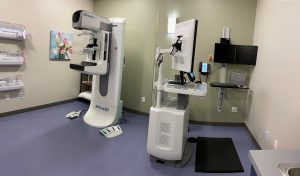While it’s estimated that one in eight American women will develop invasive breast cancer in their lifetime, numerous studies have shown that preventative breast cancer screenings—better known as mammograms—reduce the chance of dying from breast cancer by 20 to 40%.

Mammograms are especially helpful when you consider that roughly 75% of breast cancers occur in women without a family history of the disease, and it’s why Skagit Radiology is encouraging women to “Get Your Pink On” by making an October mammogram appointment at their Women’s Imaging Center (WIC) in Mount Vernon.
As part of Breast Cancer Awareness Month, the WIC will have special Saturday screening hours, by appointment-only, on October 9 and 23. Those who arrive at their appointments wearing pink will be entered into a spa day giveaway, with the winner receiving a $200 gift card to Mount Vernon’s Spero Skin Spa Salon. Women arriving for their appointments will also receive a few free items, including a nail trimming kit, first aid kit, hand sanitizer and breast education information.
Doctor Aaron T. Yu, medical director for WIC, says Skagit Radiology has been doing special Saturday screenings in October for several years now, and since moving to the Skagit Imaging Pavilion, has provided two weekends of Saturday screenings. If demand for mammograms is particularly high, Dr. Yu says a third weekend of appointments may be made in October or November.

Since many people have put off routine, non-emergency care or exams during the COVID-19 pandemic, Yu says it’s especially critical that women get up-to-date on breast cancer screenings if they’ve been holding off.
“Yearly mammograms, for patients 40 and over, are a vital part of preventative healthcare,” he says.
Fortunately, the imaging center has enacted stringent COVID-19 safety protocols for keeping everyone as safe as possible.
Imaging center employees are screened daily for symptoms when arriving at work. When scheduled, patients are asked if they have any symptoms, and upon arriving for their appointments, are screened again. “We have a person that’s dedicated to sit at the front door and screen patients as they come in,” Yu says. “If patients are symptomatic on the day of their appointment, we ask that they reschedule.”

All patients and staff are required to wear masks, and patients are provided masks if they lack their own. The imaging center’s waiting room has been reconfigured to accommodate social distancing, and Yu says patients can also wait outside in their vehicles if they wish.
In order to limit unnecessary numbers of people inside the facility, patients are not allowed to bring anyone else with them into the imaging center unless an assistant must accompany them for certain reasons, such as for mobility issues.
In addition to regular daily cleanings of rooms, especially between each patient, a professional cleaning company deep-cleans the facility each night, Yu says.
The Importance of Being Checked
One of the biggest things that drives positive outcomes in breast cancer cases is early detection. The smaller a lesion or lump at diagnosis, the better the outcome. This is especially important, Yu notes, in women who are actually closer to the age 40 threshold for recommended annual screenings.
“Younger patients tend to have more aggressive cancers,” he says. “So, we really like to increase our chances to detect these cancers at an earlier stage.”
And being that every person’s cancer is different, and imaging cannot predict a cancer’s growth rate, early detection provides the widest array of treatment options.

If it’s been a while since you’ve had a mammogram, it only takes about 25 minutes from the time you arrive to the time you leave the imaging center. This includes the check-in period, changing your clothes, undergoing the imaging, and then re-changing.
It’s also recommended to schedule a mammogram the week after your menstrual period, as breasts may be unusually tender during. Also worth noting: deodorant, talcum powder or lotion under your arms or on your breasts can appear as calcium spots on a mammogram, so don’t apply them before the exam.
Skagit Radiology, like many modern breast cancer screening facilities, relies on 3D mammography machines. Superior to older 2D equipment, 3D mammography takes multiple, thin image “slices” of breast tissue, allowing radiologists a clearer look at tissues that might be otherwise obscured when compared to 2D imagery.
“It’s really good for patients with dense breast tissue,” Yu says of 3D mammograms. “Just having dense breast tissue increases your risk of breast cancer, and one of the problems with conventional 2D mammography is that a lot of that tissue is so dense that it just kind of masks the tissue throughout the breast because you’re taking one image.”

The 3D mammography machines also have the ability to detect smaller lesions than 2D machines, they also decrease the odds of being called back for additional imaging.
When additional imagining is needed, patients will usually undergo a breast ultrasound. For women who have a greater than 20% lifetime risk of getting breast cancer, Yu says a screening breast MRI is recommended in addition to a normal mammogram. Staggered six months apart, this ensures that everything is being done to detect abnormalities at an earlier stage.
“A yearly mammogram definitely gives you the best chances to find a possible abnormality as early and small as possible,” Yu says. All in all, making time for an annual mammogram—even amid a continuing pandemic—is something that no woman should put off.
To make a mammogram appointment today, call 360.425.7275 or see the Women’s Imaging Center website.
Sponsored




































